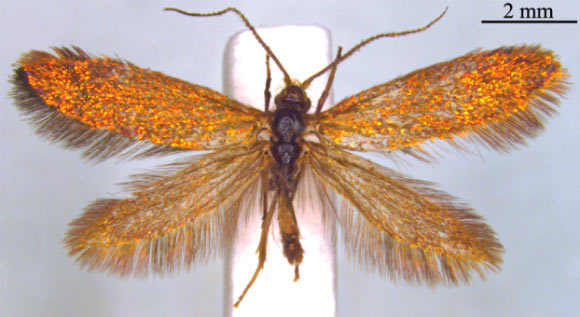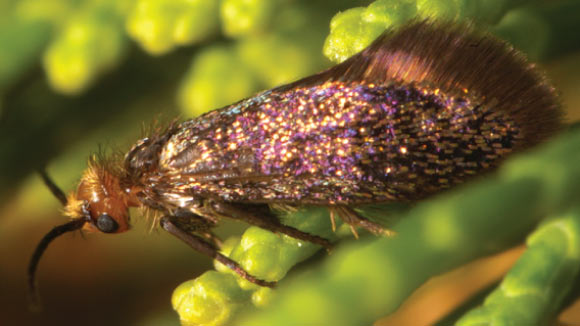An international team of entomologists led by Dr Niklas Wahlberg from the University of Turku in Finland has described an enigmatic new species of moth from Kangaroo Island off southern Australia and erected both a new genus (Aenigmatinea) and an entirely new family (Aenigmatineidae) for it.

Aenigmatinea glatzella represents an entirely new family of primitive moths, Aenigmatineidae. Image credit: Niels P. Kristensen et al.
According to the scientists, the newly-discovered species – named Aenigmatinea glatzella – is a ‘living dinosaur.’
It lives on Southern Cypress-pine trees (Callitris gracilis), a very ancient element of flora going back to the supercontinent Gondwana.
The adult moths are less than 1 cm long. Their wings are covered in scales that appear gold and purple, and the edges of the wings have feathery fringes.
They are short-lived: in just one day they emerge from their cocoons, mate, females lay their eggs, and then die.
“This new moth is small, about the size of a 5-cent piece. It has gold and purple wings with fringed edges. So far it has only been found in one place which is on Kangaroo Island off the south coast of South Australia,” said Dr Ted Edwards of CSIRO’s Australian National Insect Collection, a co-author of the paper published in the journal Systematic Entomology.
“Our research shows that it is a living dinosaur and belongs to an entirely new family of primitive moths (Aenigmatineidae).”
“This is the first time since the 1970s that a new family of primitive moths has been identified anywhere in the world,” he added.

A female adult Aenigmatinea glatzella on a Southern Cypress-pine stem. Image credit: George Gibbs.
By studying the appearance of Aenigmatinea glatzella and analyzing its DNA, Dr Edwards and his colleagues from New Zealand, Australia, and Denmark, have revealed that the evolution of moths and butterflies is even more complex than previously thought.
“By studying the moth’s structure and analyzing its DNA, our team has shown that the evolution of moths and butterflies is even more complex than previously thought,” Dr Edwards said.
“While the discovery of this new moth strengthens the evolutionary relationships between other primitive moth families, it also suggests that tongues evolved in moths and butterflies more than once.”
He added: “our fauna is so exciting we can still find new primitive species.”
“Australia is so rich in moths that vast numbers still remain to be discovered.”
_____
Niels P. Kristensen et al. 2015. A new extant family of primitive moths from Kangaroo Island, Australia, and its significance for understanding early Lepidoptera evolution. Systematic Entomology, vol. 40, no. , pp. 5–16; doi: 10.1111/syen.12115







